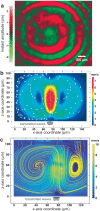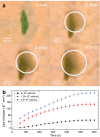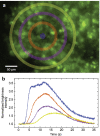Well-free agglomeration and on-demand three-dimensional cell cluster formation using guided surface acoustic waves through a couplant layer
- PMID: 35596837
- PMCID: PMC9124176
- DOI: 10.1007/s10544-022-00617-z
Well-free agglomeration and on-demand three-dimensional cell cluster formation using guided surface acoustic waves through a couplant layer
Abstract
Three-dimensional cell agglomerates are broadly useful in tissue engineering and drug testing. We report a well-free method to form large (1.4-mm) multicellular clusters using 100-MHz surface acoustic waves (SAW) without direct contact with the media or cells. A fluid couplant is used to transform the SAW into acoustic streaming in the cell-laden media held in a petri dish. The couplant transmits longitudinal sound waves, forming a Lamb wave in the petri dish that, in turn, produces longitudinal sound in the media. Due to recirculation, human embryonic kidney (HEK293) cells in the dish are carried to the center of the coupling location, forming a cluster in less than 10 min. A few minutes later, these clusters may then be translated and merged to form large agglomerations, and even repeatedly folded to produce a roughly spherical shape of over 1.4 mm in diameter for incubation-without damaging the existing intercellular bonds. Calcium ion signaling through these clusters and confocal images of multiprotein junctional complexes suggest a continuous tissue construct: intercellular communication. They may be formed at will, and the method is feasibly useful for formation of numerous agglomerates in a single petri dish.
Keywords: Acoustofluidics; Cell agglomerate; Surface acoustic wave.
© 2022. The Author(s).
Conflict of interest statement
There are no competing interests to declare.
Figures








Similar articles
-
Cell agglomeration in the wells of a 24-well plate using acoustic streaming.Lab Chip. 2017 Feb 28;17(5):876-886. doi: 10.1039/c6lc01310d. Lab Chip. 2017. PMID: 28184386
-
Controlling cell-cell interactions using surface acoustic waves.Proc Natl Acad Sci U S A. 2015 Jan 6;112(1):43-8. doi: 10.1073/pnas.1422068112. Epub 2014 Dec 22. Proc Natl Acad Sci U S A. 2015. PMID: 25535339 Free PMC article.
-
Effect of microchannel protrusion on the bulk acoustic wave-induced acoustofluidics: numerical investigation.Biomed Microdevices. 2021 Dec 29;24(1):7. doi: 10.1007/s10544-021-00608-6. Biomed Microdevices. 2021. PMID: 34964071
-
Stimulation of bone repair with ultrasound: a review of the possible mechanic effects.Ultrasonics. 2014 Jul;54(5):1125-45. doi: 10.1016/j.ultras.2014.01.004. Epub 2014 Jan 17. Ultrasonics. 2014. PMID: 24507669 Review.
-
Manipulation with sound and vibration: A review on the micromanipulation system based on sub-MHz acoustic waves.Ultrason Sonochem. 2023 Jun;96:106441. doi: 10.1016/j.ultsonch.2023.106441. Epub 2023 May 13. Ultrason Sonochem. 2023. PMID: 37216791 Free PMC article. Review.
Cited by
-
Acoustofluidics: Technology Advances and Applications from 2022 to 2024.Anal Chem. 2025 Apr 8;97(13):6847-6870. doi: 10.1021/acs.analchem.4c06803. Epub 2025 Mar 25. Anal Chem. 2025. PMID: 40133046 Free PMC article. Review. No abstract available.
-
Acoustofluidic assembly of primary tumor-derived organotypic cell clusters for rapid evaluation of cancer immunotherapy.J Nanobiotechnology. 2023 Feb 4;21(1):40. doi: 10.1186/s12951-023-01786-6. J Nanobiotechnology. 2023. PMID: 36739414 Free PMC article.
-
Sound innovations for biofabrication and tissue engineering.Microsyst Nanoeng. 2024 Nov 19;10(1):170. doi: 10.1038/s41378-024-00759-5. Microsyst Nanoeng. 2024. PMID: 39562793 Free PMC article. Review.

